Multi-coloured Pardubice postmarks
Recently I got the question what the story is behind the (multi-)coloured postmarks from Czechoslovakia, and for us motorcycle philatelists especially the Pardubice postmarks. A good moment to tell something about postmarks and their history.
Postmarks are already used since the beginning of the postal services to communicate postal indications.

In 1661 the English Postmaster General Henry Bishop invented a system to indicate on postal items when the post was handed in for shipment. This because postmen, who at that time were still paid per item by the recipient and did it as side-job next to their main job, often collected the post until they had enough to be worthwile to go for delivery. The first postmarks were therefore called Bishop postmarks, and only mentioned the month and sometimes the date. These postmarks were mainly in a dark colour (black, dark blue, purple).
When
Sir Rowland Hill introduced the first stamp, he chose the colour black for the stamp. Not very clever, as the same dark colour was used to cancel the stamps, and this was often hardly visible. Therefore it was decided to start using red ink in the post offices. But red ink was more expensive than black, and already in the first year of the stamp they switched to red for the 1-Penny stamp, and back to black for the ink.
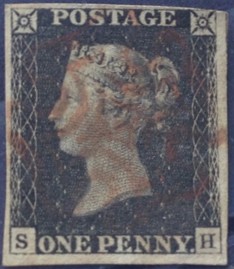
Penny Black with red cancellation postmark
The World Post Organization (UPU), originating from the General Postal Union of 1874, had in 1896 the idea to standardize the colours of stamps: green for printed matter, red for normal post and blue for international post. Off course this gave problems in case of rate changes, but the colour black was not used for stamps anymore.
Now the postmarks itself. We distinguish different kinds of postmarks on postal items, but the most important, and normally always present on post franked with stamps, is the date stamping: the postmark.
In the date stamp off course the date, but also the name or number of the post office where the post has been handed in. Often the stamping also mentions the time when the letter or card has been handed in.
Because post is often franked with multiple stamps next to each other, postmarks were often provided with extra stamping surfaces, called stamp killers. Here a manual killer.
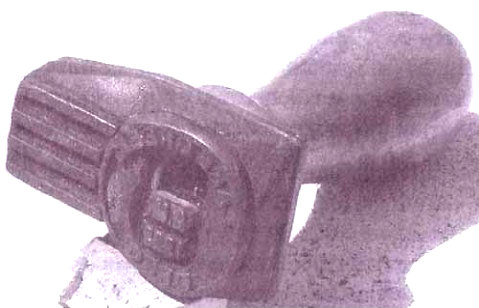
We know this kind of stampings also from the wave-shaped lines next to the postmark, applied by means of a rolling stamp or a stamping machine.

Especially for special postmarks, commemoratives, often used in special post offices (remember Pardubice), deviating colors are and were sometimes used for stampings.
Since 2005 also digital stampings
are in use, like the USA Sturgis prints well-known to us. The fact that an error can be made in this makes it even nicer for us.
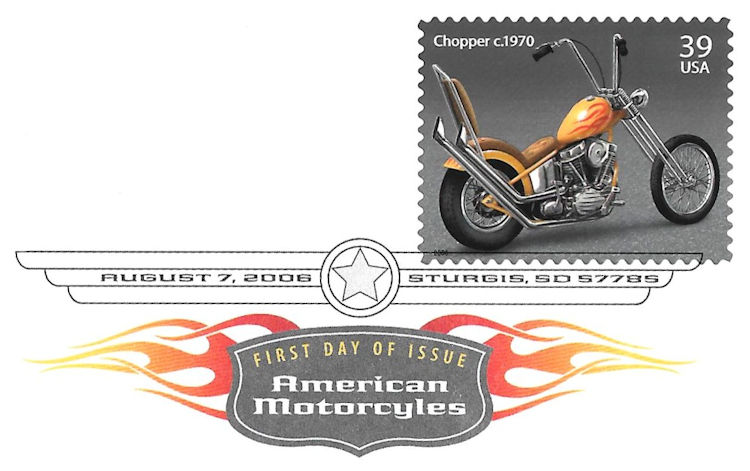
Digitally applied multi-coloured stamping used in the first hour, with the C from MotorcyCles missing
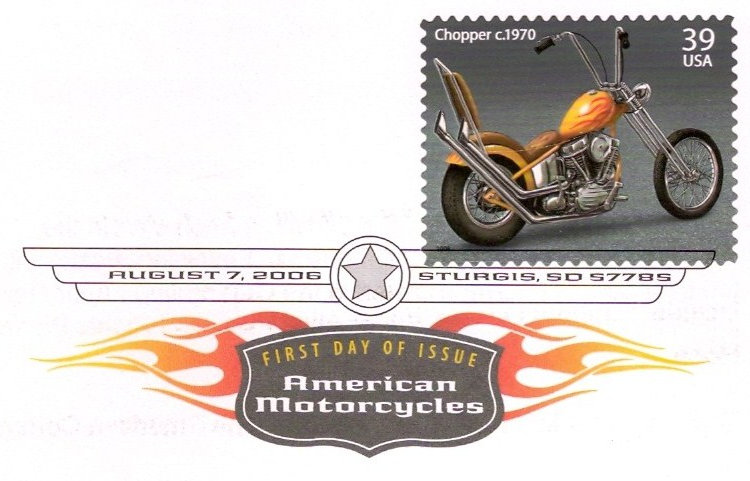
After one hour the error was discovered and corrected
Now back to the Czechoslovak Pardubice. In Pardubice there is already for a very long time a sports center, started as horse race and trotting track. Already in 1842 the race track was established, at that time off course only for horse racing. The best known, and worldwide famous, horse racing event is the Pardubice Steeplechase. In 1990 the horse race celebrated its 100th anniversary.
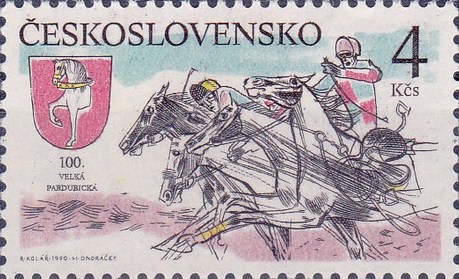
The track is not oval, but has four straight ends and four bends, and is 2200 meters long.
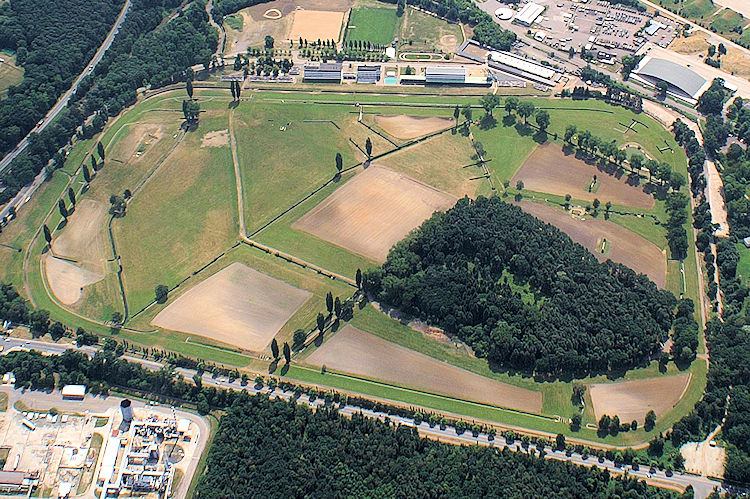
When the city had to invest money to build stands and other facilities, the entourage also had to be suited for other sports. Also organized were (amongst others) running, ball sports and cycling events, and in 1929 for the first time a Golden Helmet event was organized on the grass track. Initiator was František Hladěny, himself a talented motorcycle sportsman. In WWII, being a member of a resistance movement, he was forced by the Gestapo to jump from the roof of the Pardubice police office and died. Until now the local races, preceding the Golden Helmet races, still wear the name of Frank (František) Hladěny.
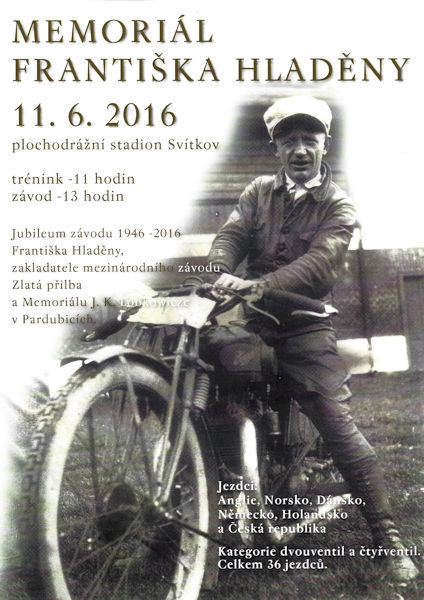
Golden Helmet speedway races are isolated competitions, of which the winner may call himself King of the event. Every city, country or club may organize his own Golden Helmet competition. The Pardubice version has been international since 1930, and belongs together with Amsterdam (Olympic Stadium) to the most famous of the world.

Red franking WC Finals 1987, also held in Amsterdam on the same track
The Speedway races in Pardubice are always held on the first Sunday in October, one week before the "Great Pardubice Steeple" horse races, and ring in a week full of festivities.
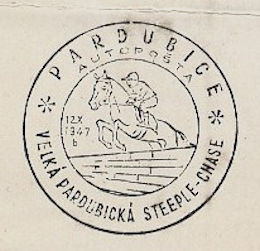
Because of the FIM requirements for track racing events the last speedway races on the horse track were held in 1963. See the article by Nico in MFN Newsletter 57.
From 1964 on the races were held on the dirt track of the speedway stadium in Pardubice-Svítkov, not far away from the horse track.
Already from 1928 on a mobile post office had been used on the horse track for philatelic purposes. These mobile post offices were used for all events, often simultaneously, and it seemed better to the Postal Service to start using a permanent space in the main building of the race track. In 1929 an office with 3 counters (a, b and c) was opened with the name “Pardubice Zavodisty” (= trotting track) that has been used until the second world war. In the war the office got damaged and from 1945 on the mobile post offices were used again.
But what about the coloured postmarks? When in 1928 the state Czechoslovakia, founded in 1918, existed ten years, the main office in Prague decided to use a red coloured stamping for festive cancellation of the post. People let massively cancel sheets of stamps with this special nice colour. Several postmasters, amongst them the one from Pardubice, liked this idea so much that they asked permission for using coloured cancellations also during other events. Unfortunately no coloured cancellations have been used on the Pardubice Zavodisty (= trotting track) in 1934, the only year that the Golden Helmet has been won by a Dutchman (Gerrit van Dijk). Another Dutchman, Poldevaart, unluckily perished during these same races.
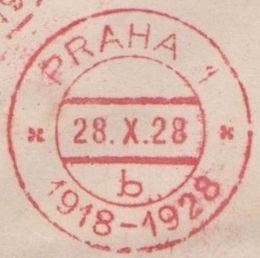
Red stamping Prague
|
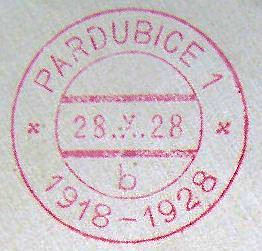
Red stamping Pardubice
|
On March 7th 1935, the 85th anniversary of President Thomas Masaryk, red ink was used, and the next months different colours appeared at other events. This resulted in the use of 2 different colours for the speedway races on the horse track in 1935. The idea was to use the colour green on the first day, Saturday September 14th, and the colour ochre on Sunday.
On the 14th only counter a and b were opened, and the official of counter c decided to start already stamping the commemorative sheets with the ochre colour. Unfortunately this made that on the Sunday the stamping pad of counter c was completely used up, and thereby he was forced to use the green colour. But counter a and b were able to use the ochre stamping pads during the whole day.
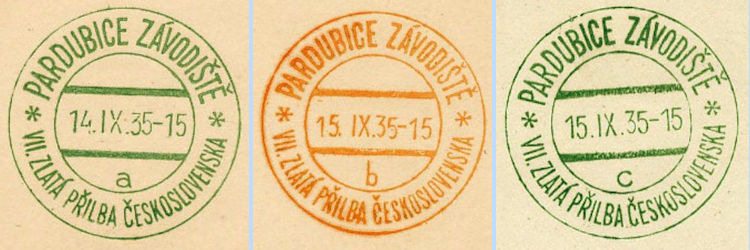
Another enthusiastic official and philatelist in Prague, Jan Jaroslav Polušny, invented a machine that could imprint multi-coloured stampings. He patented this machine in 1935.
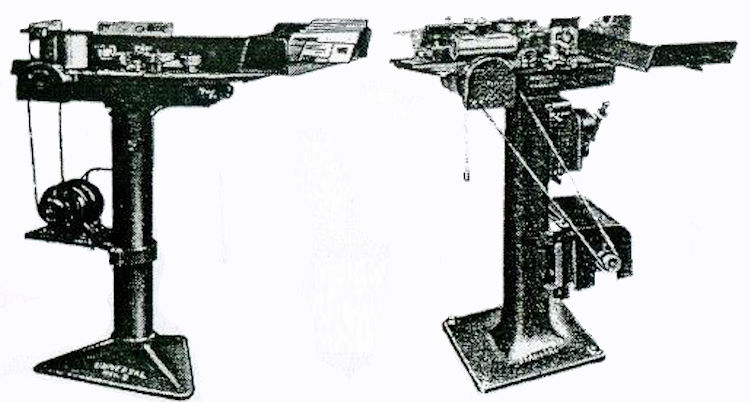
The machine printed in separate stampings a combination of several colours on the item to be cancelled. The postal item was placed in the machine, and the stamps moved along the item, each to put its own stamping exactly on the right spot. First the machine could only handle 2 colours, but once the technique was known everything became possible, and thus also 3 and even 4 colour imprints.
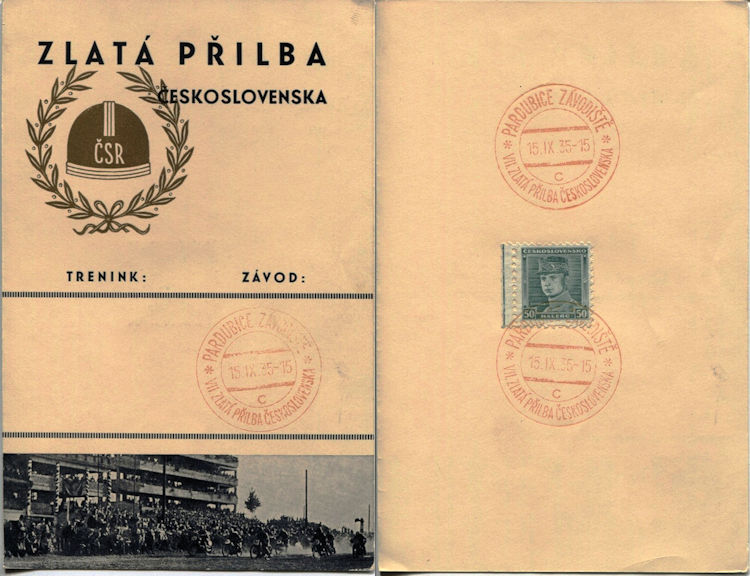
When on Sunday September 27th 1936 the 8th Zlata Prilba (Zlata = Helmet, Prilba = Gold) races were organized, the 3colour stamping of Polušny was also used there. The top circle is green, the bottom circle ochre and the middle is heraldic purple.
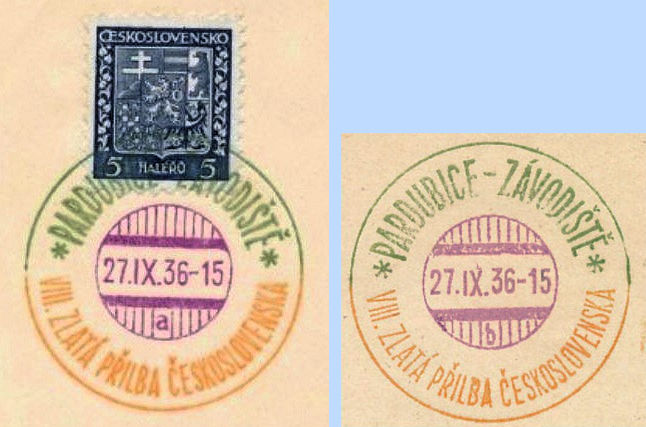
Until today I did not find any "C" from this stamping, and I think that this year only 2 counters have been used.
Due to the bad economic situation no international riders wanted to come to Pardubice in 1937, even not when a discount of 400 Crowns was promised on the purchase of a JAWA. Thus no speedway races in 1937.
one year before the Czech Auto Club Pardubice was established. This club organized in 1937 the
Bohdanec Auto-Moto-Zavody, speed races for factory teams. The races were held on a road racing track close to Pardubice, but more about this a next time.
The speedway organization became short of money and the
Bohdanec club bought off the debts for 75.000 Crowns, and therewith acquired the rights of the Golden Helmet.
In 1938 the event was again on the calender (September 4th) and also the Post was present with a 3-colour stamping, now with the top in blue, bottom in ochre and middle in green. But now there was no letter to indicate the counter.
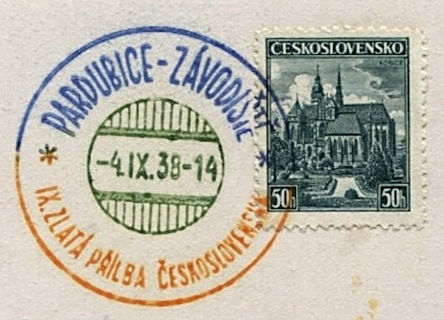
This is also the last multi-coloured stamping used on the trotting track that is important for us motor philatelists. In 1939 Bohmen and Mahren were already annexed by Germany and motorcycle races were forbidden.
Another sporting event
known to us because of the multi-colour Pardubice stampings is the J.K. Lobkowicze Memorial race. Prince Jiří Kristián Lobkowicz was a famous Czech auto racing driver of noble birth from the region Turnov. He got widely known by his racing sieges with the brand Bugatti. During a race in 1932 on the AVUS track in Berlin he perished with the new Bugatti T54 race car, that was designed and built in only 13 days. In commemoration of the prince a yearly memorial was organized in the Letni (= summer) stadium, first called Masaryk's stadium, in the center of Pardubice. This stadium was opened in 1931 by President T.G. Masaryk and was, amongst others, equipped with an oval 400 m dirt track, surrounded by a 500 m cycle boardtrack. In 1936 (the 5th remembrance year), 1937 and 1938 the memorial was graced with motorcycle races. These speedway races were held on the dirt track of the Summer stadium. The races of 1936 were won by Hugo Rosak, whose image we find back on many picture cards.
Also now the post
used coloured stampings for commemoration. For philatelists the post office was close to the stadium, and the used special stampings could be obtained there at the standard counter number 1. In 1936 this were also 2 colours. On both days, June 13th and 14th, stamping was done with both green and blue.
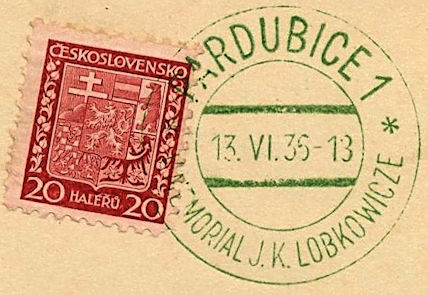
The next year the multi-colour stamping machines from Polušny were also in use there, and on counter #1 a stamping (May 30th 1937) could be obtained with on top the colour blue, on the bottom ochre and in the middle again purple.
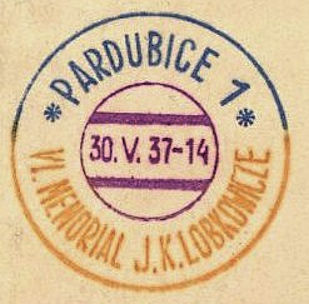
Nowadays there are still yearly sports memorials for the prince in the whole country, but in 1938 speedway races were held for the last time during the memorial in Pardubice. Also in that year a coloured postmark was used, but now only at the second counter in the post office. On June 12th during the 7th memorial a stamping with the colours black (top), blue (bottom) and green (middle) was used.
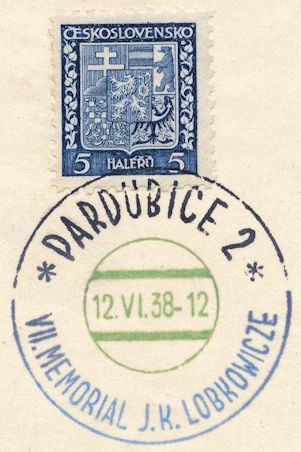
In the war everything made from iron was remelted into war material, and apart from a single 1941 colour stamp the use of colour stampings vanished with the machines.
Until now Czechoslovakia is the only country
that has used the multi-coloured stampings for cancellation of stamps, which makes them unique.
Hans de Kloet
Top - Back to former page - Home |




















